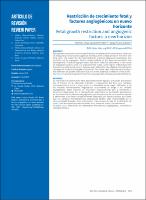Restricción de crecimiento fetal y factores angiogénicos: un nuevo horizonte
Related Resource(s)
http://www.scielo.org.pe/scielo.php?pid=S2304-51322018000300006&script=sci_arttext&tlng=ptDate
2018Author(s)
Lacunza Paredes, Rommel Omar
Ávalos Gómez, Jorge
Metadata
Show full item recordAbstract
La restricción de crecimiento fetal está íntimamente ligada a la función placentaria
por el fracaso de la adecuada nutrición y oxigenación del feto, con múltiples consecuencias a corto y largo plazo. La búsqueda de la mejor definición y de los mejores biomarcadores diagnósticos actualmente se dirige a los factores angiogénicos. Estos factores se relacionan estrechamente con la formación y desarrollo placentario. En la hipoperfusión placentaria se ha hallado alteraciones en los niveles de los factores angiogénicos, por lo que estos factores podrían ayudar a diferenciar a los fetos verdaderamente afectados por hipoxia crónica aún antes que los cambios hemodinámicos adaptativos tardíos sean evidenciables en la ultrasonografía Doppler. Esto podría tener implicancias no solo en la definición de restricción de crecimiento sino también en la potencial predicción del evento. Fetal growth restriction is intimately linked to the placental function due to its failure of adequately nurture and oxygenate the fetus, with consequences in the short and long term. The search for the best definition and best diagnostic biomarkers has currently led to angiogenic factors closely related to the placenta formation and development. Placenta hypoperfusion has been linked to alterations in the levels of angiogenic factors, and it is proposed that these could help to differentiate the fetuses truly affected by chronic hypoxia even before the late adaptive hemodynamic changes are evident by Doppler ultrasound. This could have implications not only in the definition of growth restriction but also in the potential prediction of the event.
Collections
- Artículos científicos [890]






